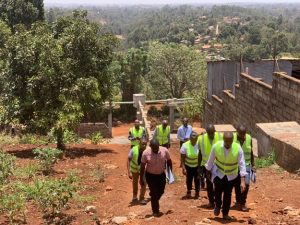Kikuyu Sewerage Project
The Kikuyu sewerage project is one of the projects under the Kenya Towns Sustainable Water Supply and Sanitation Program (KTSWSSP), supporting water supply infrastructure in 19 towns and sanitation infrastructures in 17 towns. The main objective of the program is to improve the access, quality, availability and sustainability of water supply and wastewater management services, with a view to catalysing commercial activities, driving economic growth, improving quality of life of the people, and building resilience against climate variability and change. The project is funded by African Development Bank (AfDB) and the Government of Kenya and is being implemented by Athi Water Works Development Agency. The project covers Kikuyu Township, Thogoto Township, Kidfarmaco and the environs.

Site inspection handover for the Kidfarmaco and main trunk sewerage systems on 09 March 2023
KTSWSSP is structured in three components namely: water and wastewater infrastructures; institutional development support; and programme management. Howard Humphreys has been supporting the implementation of the water and sanitation infrastructure development in secondary towns across Kenya.
Although the project area is rapidly urbanizing, it lacks an elaborate sewerage system thus wastewater is disposed-off by use of on-site sanitation systems such as septic tanks, pit latrines, and conservancy tanks. Large institutions in the area including the University of Nairobi, Kikuyu Campus, the Presbyterian University of Eastern Africa (PUEA), Kikuyu Mission Hospital and the alliance schools have invested heavily in centralized institutional wastewater collection systems that ultimately discharge into several septic tanks within their establishments. As more Nairobi residents move into satellite towns i.e., Kikuyu, developers are forced to build high-rise developments for commercial and residential purposes. The wastewater generated from these establishments is high for the onsite sanitation systems to work effectively. These on-site sanitation systems pose a great danger to ground water sources in the project area especially Ondiri Swamp and Kikuyu Springs which are important freshwater resources in the project area and parts of the neighbouring Nairobi County.
With this project, the residents of Kikuyu town can now enjoy a water borne sewerage system upon completion of a 44km sewerage system whose construction began in 2019. A total of 700 property connections are being constructed under this phase of the project targeting to connect over 1,200 properties to the sewerage system. Apart from the commercial, institutional, and residential facilities to be connected to the system, the project will also connect one of the major pharmaceuticals manufacturing company within the project area and a few industries along the Kikuyu Link road (steel rolling area.
This new sewerage system has come as a relief to residents who have borne exorbitant costs to empty their septic tanks. Exhauster services are provided by the resident water service provider, Kikuyu Water Company Limited (KIWACO) or private exhausters. Sewage from the septic tanks was initially being disposed at Limuru sewage treatment works approximately 20km away. The treatment plant is overloaded and is currently being rehabilitated under the KTSWSSP program. Following the commencement of construction works at Limuru sewage treatment plant, an alternative discharge point was identified in Ruiru approximately 50km away.
One of the property owners interviewed during project implementation and who owns an hotel in Kikuyu town revealed that he spends KES 5,000 per trip for 10,000 litre-exhauster owned by KIWACO and KES12,000 for privately owned 20,000 litres exhauster. The average number of times he empties his septic tank in a month range from 3-4 times when using the 20,000-litre exhauster. This means that he will spend an average of KES 36,000 to 48,000 per month on exhauster services for his four-storey commercial building sitting on an area of approximately 270m2. Another property owner in Kidfarmaco island who owns a 4-storey residential apartment sitting on an area of approximately 1,350m2 spends an average of KES. 144,000 to 204,000 per month on exhauster services. The frequency of emptying his septic tank is 3-4 times per week when using the 20,000 litres privately owned exhauster. The frequency of emptying the septic tanks is compounded by the huge volumes of wastewater discharged into these septic tanks with limited and usually saturated soak away systems.
Apart from the commercial relief to the residents, the project is a key driver to environmental protection and alleviation of ground water contamination. The usually saturated soakaway systems have led to effluent from the septic tanks overflowing into the road drains and eventually discharging into the freshwater sources. Also due to the high cost of emptying septic tanks, some of the residents have been forced to employ unorthodox means to manage sewage generated from their premises. Such include night pumping of sewage into the road drains which has led to environmental degradation and air pollution arising from odour release from sewage flowing on the open road drains.
The Kikuyu project area also relies heavily on boreholes (over 90% with only surface source being Kikuyu springs) for its water supply. Most of the boreholes supplying the area have been drilled along the reaches of Ondiri Swamp. The sewerage project will therefore play a key role in alleviating ground water contamination and thereby improve the quality of life and relieve the burden of waterborne diseases.

Site inspection handover for the Kidfarmaco and main trunk sewerage systems on 09 March 2023
